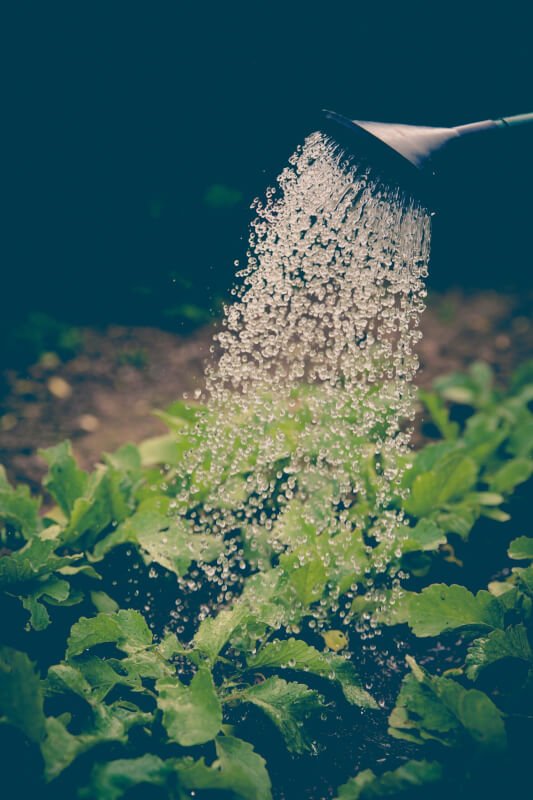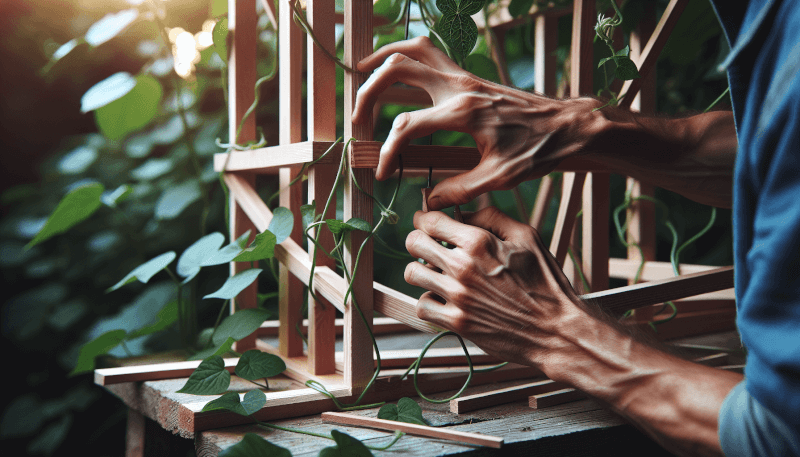If you’re a plant enthusiast looking to add a touch of elegance to your garden, then learning how to build a DIY trellis for climbing plants is just what you need. This simple yet captivating structure not only provides support for your plants, but also adds a focal point to your outdoor space. In this article, you will discover step-by-step instructions on how to create your very own trellis, allowing your plants to thrive and your garden to bloom with natural beauty.

Materials Needed
To build a DIY trellis for climbing plants, you will need the following materials:
Wooden stakes
Wooden stakes are the vertical supports that form the structure of the trellis. Choose stakes that are sturdy and long enough to provide adequate support for your climbing plants.
Galvanized wire
Galvanized wire is used to create the grid or framework for your trellis. It is a durable and rust-resistant material that will ensure the longevity of your trellis.
Wire cutter
A wire cutter is essential for cutting the galvanized wire to the desired lengths and for any necessary adjustments during the construction process.
Drill
A drill is needed to pre-drill holes in the wooden stakes and to attach the crossbars and horizontal supports securely.
Screws
Screws are used to attach the crossbars and horizontal supports to the wooden stakes. Choose screws that are appropriate for outdoor use and can withstand weather conditions.
Measuring tape
A measuring tape is necessary to measure and mark the desired height and spacing for the stakes, crossbars, and horizontal supports.
Pliers
Pliers will come in handy for cutting and manipulating the galvanized wire as needed.
Level
A level is crucial for ensuring that the stakes, crossbars, and horizontal supports are straight and level during installation.
Hammer
A hammer will be used to secure the stakes into the ground and to drive in any nails, if necessary.
Nails
Although not always required, nails may be used to provide additional reinforcement and stability to the trellis structure.
Choosing the Right Location
Before starting the construction of your DIY trellis, it is important to choose the right location for it. Consider the following factors:
Consider plant requirements
Different climbing plants have different requirements in terms of sunlight, soil conditions, and wind exposure. Take into account the specific needs of the plants you intend to grow on the trellis and find a location that can provide those requirements.
Evaluate sunlight exposure
Most climbing plants thrive in full sun or partial shade. Observe the area you have in mind for your trellis and assess how much sunlight it receives throughout the day. Ensure that the location you choose will provide the necessary amount of sunlight for your plants to grow and thrive.
Assess wind conditions
Climbing plants can be vulnerable to strong winds. Consider how exposed the area is to wind and choose a location that offers some protection, such as near a wall or fence.
Check soil conditions
The soil should be well-draining and fertile to support the growth of climbing plants. Evaluate the soil conditions in the area where you plan to install the trellis to ensure it is suitable for your plant’s needs.
Determine available space
Consider the available space and the size of the climbing plants you intend to grow. Ensure that the location you choose can accommodate the desired height and spread of the plants without overcrowding.
Design and Planning
Once you have chosen the right location for your trellis, it’s time to design and plan its construction. Follow these steps:
Decide on trellis type
There are various trellis designs to choose from, including fan-shaped, ladder-like, and grid patterns. Decide on the type of trellis that will complement your garden aesthetics and suit the needs of your climbing plants.
Measure and mark the desired height
Using a measuring tape, measure and mark the desired height of your trellis on the wooden stakes. This will guide you during the installation process and ensure a consistent height for all the stakes.
Calculate the number of stakes needed
Depending on the size of your trellis, calculate the number of wooden stakes you will need. Consider the spacing between the stakes and the trellis design you have chosen.
Determine the spacing between stakes
The spacing between the stakes will depend on the size of your climbing plants and the trellis design. Generally, a spacing of 1 to 2 feet between stakes is suitable for most climbing plants.
Sketch the trellis design
Before starting the construction, sketch the trellis design on paper. This will help you visualize the final product and ensure that all the elements are properly planned and aligned.
Preparing the Materials
Now it’s time to prepare the materials you will be using for the construction of your trellis. Follow these steps:
Cut wooden stakes to desired height
Using a saw or a sharp tool, cut the wooden stakes to the desired height that you marked earlier. Make sure the stakes are cut evenly to maintain a consistent height for the trellis.
Pre-drill holes for screws
Using a drill bit smaller than the diameter of the screws you will be using, pre-drill holes in the wooden stakes where the screws will be inserted. This will prevent the wood from splitting when you attach the crossbars and horizontal supports.
Prepare galvanized wire lengths
Measure and cut the galvanized wire to the desired lengths. Make sure the lengths are suitable for creating the grid or framework of your chosen trellis design.
Straighten and untangle wire
If the galvanized wire is bent or tangled, use pliers to straighten and untangle it. This will make the installation process easier and ensure a neat and organized appearance for your trellis.
Measure and cut wire
Measure and cut the galvanized wire to the desired length for each section of the trellis. This will depend on the dimensions of your trellis design and the spacing between the stakes.

Setting Up the Stakes
The stakes will form the vertical supports of your trellis. Follow these steps to set up the stakes:
Dig holes for the stakes
Using a shovel or a post-hole digger, dig holes in the ground at the locations where you marked for the stakes. The depth of the holes should be at least one-third of the length of the stakes to ensure stability.
Place the stakes in the holes
Insert the wooden stakes into the holes, making sure they are positioned straight and upright. Adjust the depth if needed to ensure the desired height and levelness.
Ensure they are straight and level
Use a level to check if the stakes are straight and level. Make any necessary adjustments by adding or removing soil from the holes until the stakes are perfectly aligned.
Secure stakes with soil or concrete
Fill the holes with soil and firmly pack it around the stakes to secure them in place. For added stability, you can also use concrete to anchor the stakes. Follow the instructions provided with the concrete mix for proper mixing and application.
Attaching the Crossbars
The crossbars will provide additional support and structure to your trellis. Follow these steps to attach the crossbars:
Measure and mark the desired height of crossbars
Using a measuring tape, measure and mark the desired height for the crossbars on the stakes. This will ensure uniformity and consistency in the placement of the crossbars.
Pre-drill holes in the stakes
Using a drill and a drill bit slightly smaller than the diameter of the screws, pre-drill holes in the stakes where the crossbars will be attached. This will make the screwing process easier and prevent splitting of the wood.
Attach crossbars using screws
Align the crossbars with the pre-drilled holes and attach them to the stakes using screws. Make sure they are tightly secured and level with the help of a level.
Ensure they are level and secure
Use a level to check if the crossbars are level across the entire trellis. Adjust the screws if necessary to ensure that the crossbars are straight and securely attached to the stakes.

Installing the Horizontal Supports
Horizontal supports will provide additional stability to the trellis structure. Follow these steps to install the horizontal supports:
Measure and mark the desired spacing for horizontal supports
Using a measuring tape, measure and mark the desired spacing for the horizontal supports on the stakes. Make sure the spacing is consistent and aligned with the design of your trellis.
Pre-drill holes in the stakes
Using a drill and a drill bit slightly smaller than the diameter of the screws, pre-drill holes in the stakes where the horizontal supports will be attached. This will prevent the wood from splitting when you insert the screws.
Attach horizontal supports using screws
Align the horizontal supports with the pre-drilled holes and attach them to the stakes using screws. Make sure they are tightly secured and level.
Ensure they are level and secure
Use a level to check if the horizontal supports are level and properly aligned. Adjust the screws if necessary to ensure a straight and secure installation.
Creating the Wire Grid
The galvanized wire will form the grid or framework for your climbing plants to grow on. Follow these steps to create the wire grid:
Attach one end of the wire to a corner stake
Starting at one corner of the trellis, attach one end of the galvanized wire to a stake. Use pliers or a hammer to secure it in place.
Stretch the wire to the opposite corner stake
Stretch the galvanized wire tightly to the opposite corner stake, making sure it is straight and taut.
Secure the wire tightly
Attach the other end of the wire to the second corner stake, ensuring it is tightly secured. Trim any excess wire if necessary.
Repeat the process for the remaining sides
Repeat the process of attaching and stretching the wire for the remaining sides of the trellis. Make sure the wire is evenly spaced and tightly secured to create a sturdy grid.

Training the Climbing Plants
With your trellis structure complete, it’s time to train your climbing plants to grow on it. Follow these steps:
Plant the climbers near the trellis
Plant your climbing plants near the base of the trellis. Make sure they are positioned close enough to the trellis structure for their tendrils or stems to reach it easily.
Gently guide the stems towards the trellis
As the plants grow, gently guide their stems towards the trellis. Avoid forcing or pulling the stems, as this can damage them. Allow the plants to naturally attach themselves to the trellis.
Secure the stems to the trellis with twine
Use twine or soft plant ties to secure any loose stems or tendrils to the trellis. Be careful not to tie them too tightly, as this can restrict their growth.
Regularly prune and train the plants
Regularly prune and train your climbing plants to encourage healthy growth and prevent overcrowding. Remove any dead or damaged growth and redirect the stems to ensure they grow along the trellis.
Conclusion
Building a DIY trellis for climbing plants is a rewarding and practical project. By carefully choosing the right materials, planning the design, and following the step-by-step instructions, you can create a sturdy and attractive trellis that will support the growth of your climbing plants. With proper care and maintenance, your trellis will provide a beautiful vertical element to your garden and allow your plants to flourish. So go ahead, get your materials ready, and start building a trellis that will transform your garden into a stunning oasis of greenery. Happy gardening!



